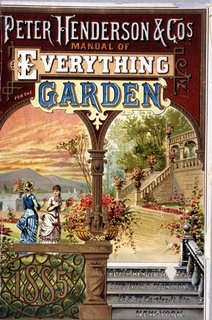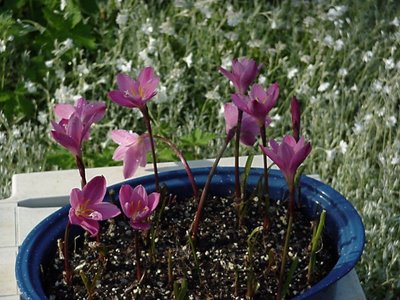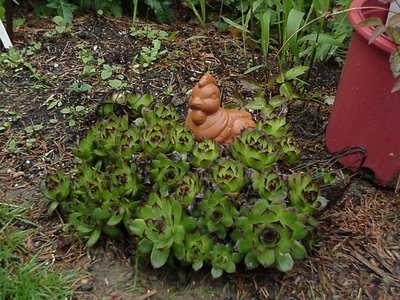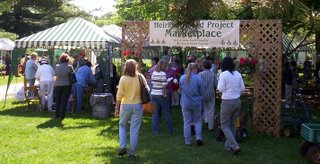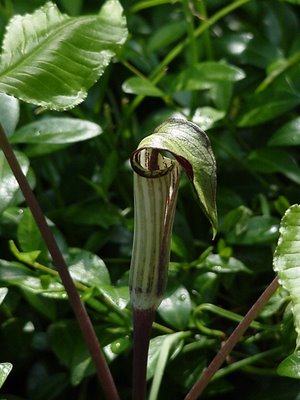In the garden:
Commercial culinary ginger is Zingiber officinalis.
Requires little care. Keep moderately moist. 50% + humidity.
Ginger should receive full sun-to part shade. Humus-rich soil. ph 6.5 well drained soil.
Divide rhizomes in early spring; plant horizontally 1 inch deep.
Harvest: Rhizomes in late autumn, cutting off leafstalks and removing fibrous roots. Keep a rhizome to start the next year's plants.
I planted one in summer, 2000 from Meijer's produce department. It grew!
The stems and leaves were so thin they were surprising to me.
The leaves developed yellow spots but it didn't seem to hinder the plant. the stress of mind and hail shredded the leaves as well. Seems to need more protection from extreme weather.
In February, the stems and leaves turned yellow, one by one, and started to drop off (in the same way that voodoo lily scapes do, at the base). By Feb 25th the whole plant was dormant.
2001: The replanted rhizome did well, the leaves were healthier and not spotted at all this year. It produced a nice replacement rhizome as well as it's own smaller one. Behaved the same, but I guess it yellowed in mid-winter, maybe December. I left it out to dry and pretty well forgot it until March.
2002: Spring: still looks viable. Planted the best part in a 8" plastic pot, kept it outside in summer and indoors in winter. This one looks healthier than last year- the leaf fronds are thicker and taller. Started dying back again in January, and I quit watering, though I left it in the S window. Gradually died off, I unpotted it Jan. 30, 2003 and took a few pictures of the roots- healthy, the tubers are much rounder and shinier than the store-bought tubers. I am keeping one half, broken away as I unpotted it, to use, and one will be repotted right away.
The repotted root took a long time to resprout, with the cool spring, it may have been waiting for warmth?
Sept. 2003: The gingerroot in the refrigerator rotted/molded. I didn't use it!!!
The replanted root looks just great, best yet. No spots, no yellowing, no shredded leaves. But the root BURST its pot! Needs to be repotted.
I repotted it into a much larger clay pot, but cut half of the storage root off to use.
Time to start another ginger. Bought a big one in April in Meijers' produce department, and put it under the light, bare. May 2006: Cut it in three - one to use now, and two to plant in the big flat bowl-shaped pot. The nubby tips are turning green and the outermost tips are very green and starting to sprout.
(See ginger folder in 'Recipes' file...)
Buy fresh gingerroot at Meijers- costs about $2/lb. A very large root is about 1/2 lb, or 2 cups prepared fresh pieces. December 2000: I used the second recipe for candied gingerroot, the third looks good too.
The Best Use: peel and slice into vodka, store in refrigerator. Slices are useful indefinitely, the vodka picks up the ginger flavor.
OR- Candied Ginger
CANDIED GINGER
1 c Ginger Root -peeled and thinly sliced
1 c Water
1/2 c Maple Syrup
In a small saucepan stir together the ginger,water and maple syrup. Place over medium heat and simmer untill liquid is completely evaporated about 25 to 30 minutes. Watch carefully during the last 10 minutes of cooking to prevent syrup from burning. Seperate pieces and place on a lightely greased cooking cooling rack .Dry in a 200 degree oven untill all syrup is absorbed and pieces snap when broken,about 2 hours.
From Rodale Stocking up III cookbook.
Candied Ginger
HERB COMPANION, Oct/Nov 1997
1/2 pound fresh ginger
water to cover
1 1/2 cups sugar
1 1/2 cups water
2 tablespoons light corn syrup
Crystallizing ginger is a lengthy process, but having these choice sweets on hand is reward enough.
1. Peel 1/2 pound fresh ginger and slice 1/4 inch thick. Bring to a boil in water to cover. Simmer, covered for 2+1/2 hours. Drain, simmer in fresh water for another hour, or until tender. Drain.
2. Bring to a boil 1+1/2 cups sugar, 1+1/2 cups water, and 2 tablespoons light corn syrup; cook for 2 minutes. Add the ginger. Remove from the heat and let stand until cool, or overnight.
3. Again bring the syrup to a boil. Simmer, stirring occasionally, for 1 to 3 hours, or until the ginger is translucent. If the syrup thickens too quickly, thin with a little hot water.
4. Remove the pan from the heat and set the ginger pieces on a wire rack to dry for a few hours. Roll them in granulated sugar and store in a glass jar.
(May get moldy.)
Third recipe: Instructions:
Day 1: Scrape and cut into 1/4 inch slices enough non-fibrous young Ginger root to make 1 quart. Put the slices into a large non-aluminum pat and cover generously with water. Bring slowly to the boil, simmer, covered until tender (20 min). Add 1 cup sugar and stir until the mixture boils.
Remove from heat. Cover and let stand overnight at room temperature.
Day 2: Recook, simmering gently for about 15 min (after coming to the boil). Add 1 seeded sliced lemon and 1 cup light corn syrup. Uncover and simmer 15 minutes longer, stirring occasionally.
Remove from heat and let stand covered overnight.
Day 3: Bring the mixture to the boil again and add 1 cup sugar and simmer for 30 min STIRRING CONSTANTLY (burns easily). Add 1 cup sugar, bring back to the boil and remove from heat.
Cover and let stand overnight again.
Day 4: In the fourth cooking, bring the mixture to a boil once more. When the syrup drops heavily from the side of a spoon, and the ginger is translucent, pour the mixture into sterile jars and seal. This yields about 5 cups.
If you want Candied ginger...drain the ginger after the last cooking. Reserve the syrup for flavoring sauces and allow the slices to dry on a sheet or better still a rack, overnight. When well dried, roll in granulated sugar and store in tightly covered glass jars.
You can then boil the reserved liquid until it is reduced to a syrup with a consistency somewhere between maple syrup and honey. This will intensify its flavor. This syrup can be used for pancakes, waffles, or ice cream, and is an extra bonus for making your own candied ginger.
Ginger Compress
1/2 c Fresh Ginger Rhizome
2 c Water
[From Herbal Medicine for Dummies]
1. Grate the Ginger into a small saucepan.
2. Add the water and simmer for 15 minutes.
3. Let steep for 15 minutes.
4. Soak a washcloth in the strong tea and apply to painful or stiff muscles until the compress cools. Do this 3 to 4 times and then repeat the process 2 to 3 times a day.
Vary it: For inflamed muscles and strong pain, try alternating the ginger compress with a cold or even icy compress with 1 minute of the cold to 4 minutes of the hot.
Notes: Try this ginger compress for back strains, sprains, bruises, and other injuries. You gain the most benefit with this herbal treatment by using it several times a day for a few days.
Ginger Info
(Zingiber officinale) The feeling of nausea is a symptom
that can accompany a wide range of organic or metabolic
disorders and emotional trauma. Ginger is used for all
types of nausea, including morning sickness and motion
sickness. It has a warming effect and is supportive to the
digestion while stimulating circulation.
Ginger has a protective effect on the stomach and liver
as well, and is the best spice to use for people with liver
and digestive problems. It is taken as a powder in capsules
for alleviating nausea (2 capsules 3 times daily), as a tea
by simmering dried or fresh ginger slices, or as a tincture
(2 droppersful 2 to 3 times daily).
==================================
GINGER (herb of the Moon) -- used to make sure
your spells are effective. Ginger is eaten before spells
to make them successful, or simply added to herbal
mixtures, also used for love spells.
=========================
From: Herbs for the Home, McVicar
This is good for indigestion, flatulence, nausea, and
poor circulation. Chewing a piece of any ginger is an
effective deterrent to travel sickness. Ginger tea
is good for flus and colds.
========================
LLewllyn's 1999 Magical Almanac
Ginger, know in ancient China and India, tones,
uplifts and warms the system, stimulates digestion
and circulation, calms upset stomach, and relieves
nausea, aches and pains. Ginger can be eaten in
candied slices, honey-based syrups, encapsulated
or drunk as a tea.
===============================
Ginger Tea helps appetite loss, motion sickness,
up-set stomach, relieves gas, loosens phlegm, and
soothes earaches. To 1 teaspoon of ginger add 1 cup
boiling water. Steep 5 minutes. (By Diane Kennedy
Snyder of Diane's Herbal Shop )
============================
Ginger: masculine, Mars, Fire. Magical attributes:
Power, success, love. History/Uses: Back to Egypt
in the time of Cheops, people were making gingerbread;
4400 years ago, the Chinese were importing this
herb for the same reason, and to act as an aid to
indigestion or colds (tea form).
Carry the root of ginger in your purse to ensure
prosperity, or make it into a fine drink for summer
days.




